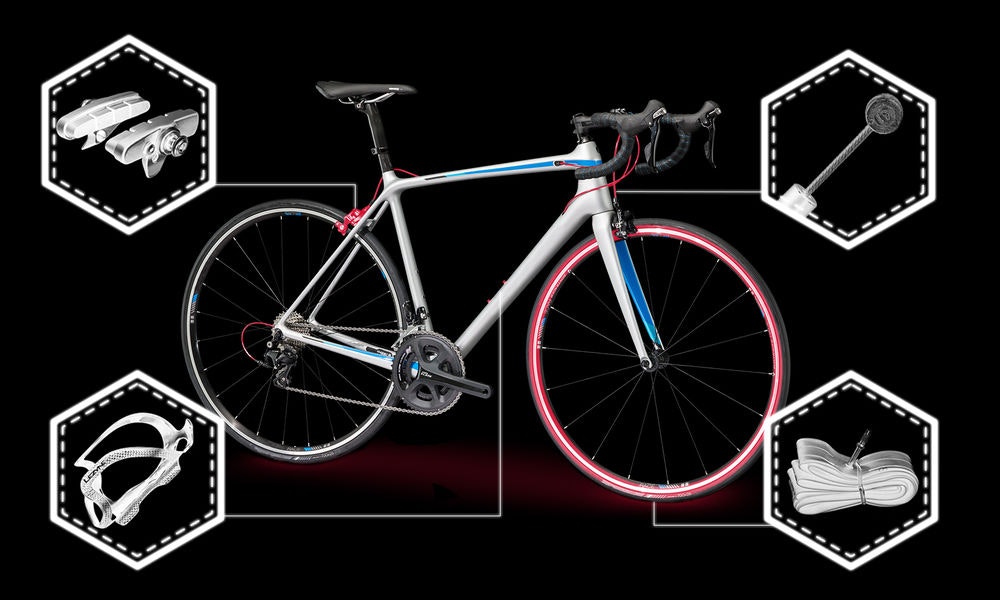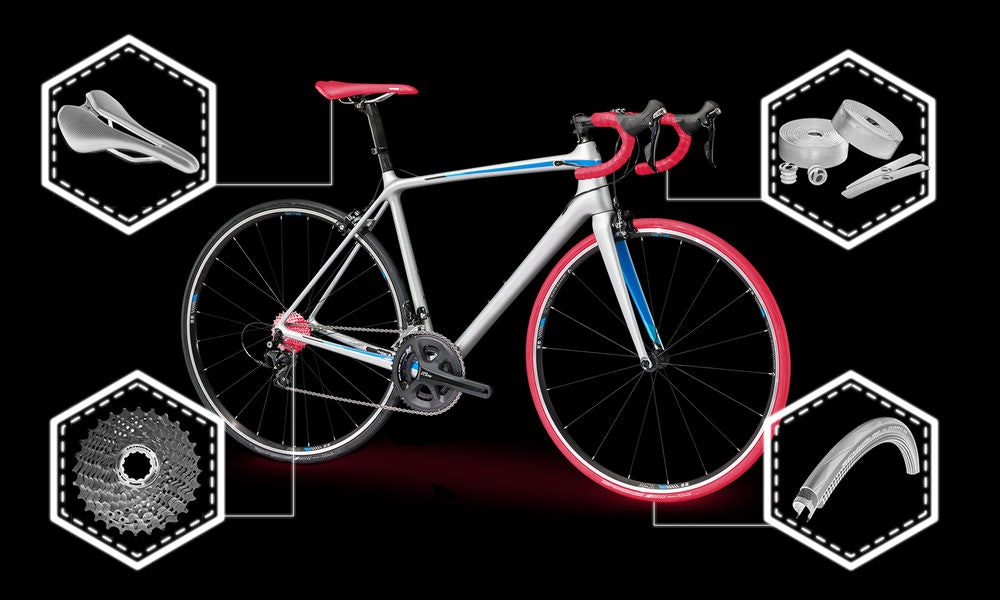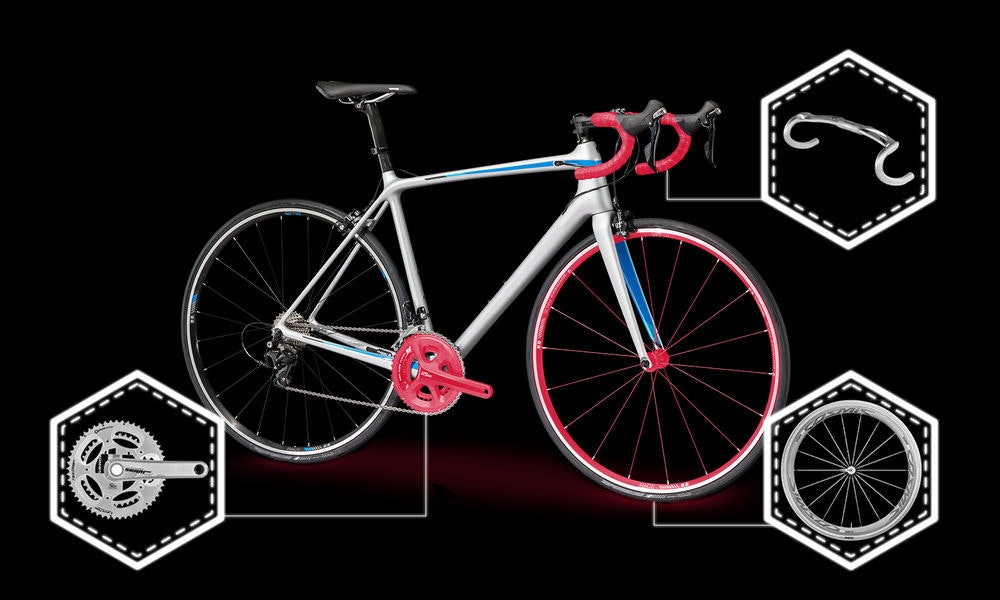The great news when it comes to cycling is that you can get an entry level bike and start riding for minimal financial outlay. There will come a time, however, after the cycling bug has bitten, that you'll want to upgrade your bike to make it faster, or more comfortable or just a little more unique. And when that time comes it can be hard to know where and on what you should be spending your money on. If you have an entry to mid-range bike and are looking to take your bike to the next level to start racing or go to the front of your bunch ride, here are the best value upgrades for your bike, from the most cost effective quick fixes to more expensive options.

Tubes
There are two common types of tubes which could make more of a difference to your bike's performance than you think. Tubes are either butyl or latex, the latter considered a higher performing option as they are lighter and more supple than butyl tubes. The reduced weight lowers rotational weight and the more supple material actually reduces rolling resistance! Latex tubes are more expensive and do require more frequent inflation as they will leak air faster than butyl due to the thinner barrier. Latex tubes can also be more prone to punctures given the material's thickness, however, a good set of tires will have greater influence on your chance of getting a puncture than tube choice.
If you have a dedicated set of race wheels, consider swapping to latex tubes to save some weight. If you ride the same wheelset for training and racing, considering swapping to latex tubes and fast tires on race day to give you a little edge.
Price range: $3 - $15 each.
Cables
One of the cheapest and often forgotten about bike upgrades is new cables, resulting in improved shifting and braking performance. You'll know for sure your cables need replacing if your shifting deteriorates beyond adjustment or your brake levers become harder to pull. Depending on how often you ride and in what conditions, aim to replace your cables each season (if you are a regular rider that prefers to stay dry) or twice a year (if you ride a lot in all conditions). Smooth shifting is crucial in racing as you don't want to miss an attack or be fumbling around with your gears approaching a sprint finish. It could also ruin your day if you can't get in or out of the small or large chain ring on a hilly ride.
We suggest using high-quality cables with either stainless steel or coated inner cables. ‘Anti-Compression’ housing, which features kevlar reinforcement, is proving a popular upgrade for those seeking the crispest feeling brakes and snappiest shifting.
Price range: $3 - $30
Brake pads
Here's a great performance upgrade for those with entry level bikes. Good brake pads will be safer by providing better power, modulation, and improved performance in wet weather. Having reliable braking will provide you with additional confidence to push harder into corners.
For those with carbon wheels, the right choice of brake pads is essential as the wrong ones will lead to a screaming noise when force is applied, poor performance and possibly even damage to the brake track. The compounds used for carbon wheels are much softer than ones used for alloy brake tracks which compromises lifespan, so staying on top of rim wear is crucial. Look for specific brake pad and wheel combinations like Zipp's Tangente Platinum Pro Evo Brake Pad if you have Zipp wheels or ENVE's specific brake pads which work best with their molded-in texture brake tracks found on the Smart ENVE System (SES) wheels.
Many basic road bikes come supplied with generic road bike calipers that struggle to produce power even after a brake pad upgrade and so new brake pads may not be enough. In these cases, changing out the whole brake calipers to something like a Shimano 105 may just prove to be a very nice upgrade.
Price range: $20 - $75
Bottle cages
When thinking about upgrading pieces of your bike, it's easy to get carried away and think about the big ticket items like wheels and drivetrain but it's often the little things that make the difference to the everyday experience. Bottle cages fall into this category, potentially saving you weight, removing any annoying rattling and also providing a secure hold for your bottles if you fancy going off road or ride on rough roads. A light weight set of bottle cages may only save you 50 or 100 grams, but it's the reduced rattles that are a true pleasure. Choose from aluminium, plastic or carbon (depending on your price range), and look for rubber grippers or some other form of security to hold your bottles in place. You can even go so far as to match them with your bike or bottles. Some of our favorites include the Specialized Rib Cage II or Elite Custom Race if on a budget, or Arundel Madible where money is no object.
Price range: $5 - $75
[externalhotoffer group="EHO_1"]

Bar Tape
As a key touch point, your handlebars and consequently handlebar tape are important. Updating your bar tape can increase comfort and bike control at a low cost, it also enhances the look of the bike which can do just as much for your mental state as many other upgrades. Bar tape varies in thickness and material and is sometimes supported by a gel layer to soften road vibration. It can be thin to increase feedback from the bars and the road if you like to be at one with your bike. It can also be tacky to improve grip if you prefer to ride with no gloves or when it starts raining.
Reigning World Champion Peter Sagan uses 'Sticky Kush' bar tape from Supacaz, a high performing option that is available in single and multiple color options, as well as fading and print options to suit any number of different tastes. A similar rubberized option is Lizard SKins' DSP tape.
Price range: $20 - $60
Tires
Few components impact on ride quality and performance more than your tire choice. Through clever tire choice, you can save weight, reduce rolling resistance, increase traction, prevent punctures and improve comfort. A good set of tires can provide almost the same performance gains as a set of aerodynamic wheels. In short, tires should be high on your list of bike upgrades.
Choosing a wider tire can save you as much as 25% energy compared to a skinnier tire. It also provides greater comfort, being able to run at a lower pressure and absorb much of the road vibration you would otherwise feel. The majority of the pro peloton run 25mm tires as standard, some even opting for 28mm and larger for the Classics or where frame designs allow for it.
So the take home message if you are after a performance orientated tire, is to go for 25mm width (check clearance on frame), weighing approximately 200 grams, with some form of puncture protection and a smooth tread pattern. Continental tires are hugely popular in the professional peloton and their GP 4000S option ticks all the above boxes regarding weight, rolling resistance and puncture protection. Vittoria's new Graphene Corsa Clincher is another good option if you prefer the old school 'gum wall' aesthetic.
Price range: $30 - $125
Cassette
Upgrading your drivetrain can be an expensive exercise, so upgrading one component can be a cost effective way to still reap some benefits. The cassette is where you will notice the biggest difference, potentially providing you with a larger gear range and significant weight reduction. Up until recently, most bikes came with an 11-25 cassette, and while that remains a good option for flat to undulating terrain, having an 11-28 or even an 11-32 cassette provides the platform for epic adventures and scaling steep climbs. The ratio allows you to spin as your legs fatigue and avoid you churning the cranks to climb steep bergs. Be aware if you do opt for a huge 11-32 cassette, you'll likely also require a longer derailleur. A 11-28 cassette should fit your current setup without issue though. If you do change your cassette, be sure to check your chain for wear and appropriate length, if in doubt, change that too.
Many bikes will equip bikes with a lower grade cassette as a way to cheekily cut cost, and as it's a chunk of steel, weight savings await. For Shimano users, the best value for money typically sits in an Ultegra cassette.
For more on cassette, cranksets and groupsets, check out our road bike groupsets: what to know article.
Price range: $45 - $220
Saddle
Without doubt, the most significant contact point of your bike is the seat, but how many of us are still sitting on a seat that's not quite right, gives us sore spots or was just the one that came with the bike? Choosing the correct saddle can improve your comfort, power and make for a more enjoyable riding experience – but it's often a challenge to find that holy grail where there are hundreds of options to try.
Saddles come in all different shapes and sizes to cater for all different body types and levels of flexibility. Many companies have their own fitting systems and beliefs, with saddle width being one the most commonly accepted tool to finding the right saddle. Brands also offer shorter noses, wider bases, cut out channels and countless other options in search for the perfect fitting saddle that doesn't compromise blood flow and create unwanted pressure. Saddles are truly unique to the rider, so what works for one person is no guarantee to work for another, so don't suffer in silence, get a saddle fitted to your exact needs and enjoy all-day comfort.
Many good bike stores offer demo saddles to try on your bike for a few rides before deciding. Try a few out if you're unsure. And it's worth remembering, that even the right saddle with a poor bike fit can be extremely uncomfortable.
Price range: $35 - $330
[externalhotoffer group="EHO_2"]

Handlebars
Handlebars, along with the saddle and pedals, serve as the contact points between you and your bike, therefore, they should be an important consideration when you are thinking about improving your bike. Handlebars come in different sizes, widths, shapes and materials, so choosing the right one can be tricky.
Starting with material, handlebars will likely be either aluminium (alloy) or carbon. Carbon bars are stiff and lightweight but far more expensive than an alloy bar. Regardless of material, choosing the right width, thickness and shape for you is likely to provide you with more benefit than the material it's made from.
The width of your bars will largely depend on your riding style and shoulder width. A common approach in choosing handlebar width is to match it with the distance between your AC joints (the small bumps on the top of your shoulders). Doing so will ensure a comfort and stable ride, however, riders seeking an aggressive and aero position may look to go narrower, while those seeking additional stability on descents may benefit from going wider.
Handlebar shape is another consideration with different amounts of reach (the distance the bar extends forward from the clamp area), drop (the distance between the clamp area and the bottom of the bars) and bend (the shape of the bar which could be flat, curved or middle ground between the two) to decide on. The different shapes, including 'ergo', 'compact' and 'traditional' will affect your position, hand position and overall comfort and so selecting the right option is paramount. Compact handlebars, such as the Zipp SL70 and 3T ErgoNova, are arguably proving to be the most popular upgrade for comfort reasons, with such a design typically offering a shorter reach to the brakes and gear shifters.
Price range: $40 - $360
Wheels
We are starting to get into the higher price bracket but no upgrade on your bike will influence ride performance more than a wheelset. Our road bike wheels: what to know article outlines all the positives a good wheelset can provide to you; 'faster speeds, better handling, aerodynamic benefits, reduced weight, increased durability and improved overall ride quality.'
Lightweight wheels keep rotating weight down so are great for climbers while deeper profile aerodynamic wheels reduce drag, therefore increasing your speed. Whichever category you fall into, a new set of wheels will elevate your performance more than any other upgrade. If you are after a lightweight set of wheels, look for a low profile option of equal to or less than 30mm depth and around 1,400grams for the set. If an aerodynamic set is on your radar look for a 40mm depth profile or greater with a wide external rim profile. When measuring externally, anything under 19mm is considered narrow by current standards, while anything over 22mm can be considered wide.
Price range: $545 - $2900
Power meter
A power meter is a costly investment but it's one that you can likely take with you and swap between bikes, it's also the only upgrade we've listed that is designed to improve the rider, not simply the bike. Riding with a power meter allows you to better track and analyse your riding which will lead to more targeted training and performance gains.
Power meters can provide you with information regarding your energy output and suggest rest or recovery periods as a result. And the measurements are completely objective, not influenced by weather or road conditions like speed, and not influenced by your physical state like heart rate. The power you push is the power you push, so you can be sure if you see improvements they are legitimate.
Power meters come in a variety of different options whether that be crank, pedal or hub based. There's multiple different price points, weights and battery life to consider too. Stages is a great option for those entering the market, offering a crank based system measuring the non-drive side forces and communicating via ANT+ to a GPS computer or Bluetooth to a smartphone app. Stages is a cost effective option that has easily replaceable batteries and is one of the lightest available.
Price range: $500 - $2180
New bike
Of course, the best upgrade is a new bike and it might not sound as crazy as it seems. Before you start upgrading different elements of your bike, figure out what those upgrades will cost you and see how it compares to a new bike with similar features after you factor in the selling of your old bike. By the time you have forked out for new handlebars, better wheelset, various parts of your drivetrain and potentially more, you could have bought a new bike with all of those features and the most up to date technological features.
Price range: whatever your budget will allow.
[externalhotoffer group="EHO_3"]
Always remember, the value of the upgrade is unique to each person, so while for some, a seemingly expensive upgrade may be questionable, if that upgrade improves their riding experience and they are happier on the bike as a result, it's entirely worth it. At least that's what we tell our better halves when we want something new and shinny.
Choosing the right bike from the start will of course result in less need for upgrades and a better-performing machine so check out our ultimate guide to buying a road bike before your next purchase.
Follow BikeExchange: Email | Facebook | Twitter | Instagram | YouTube | STRAVA





